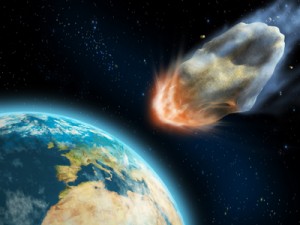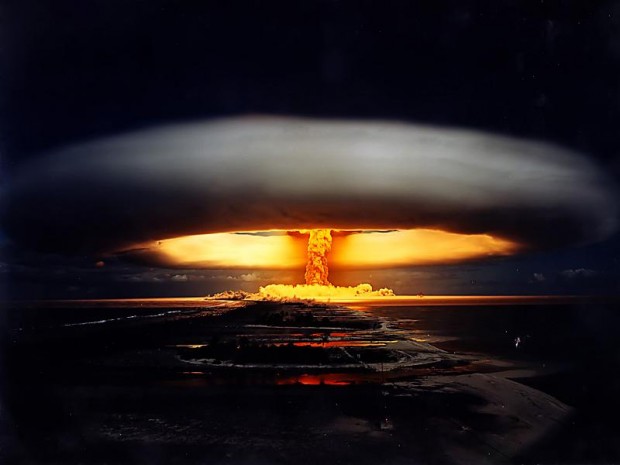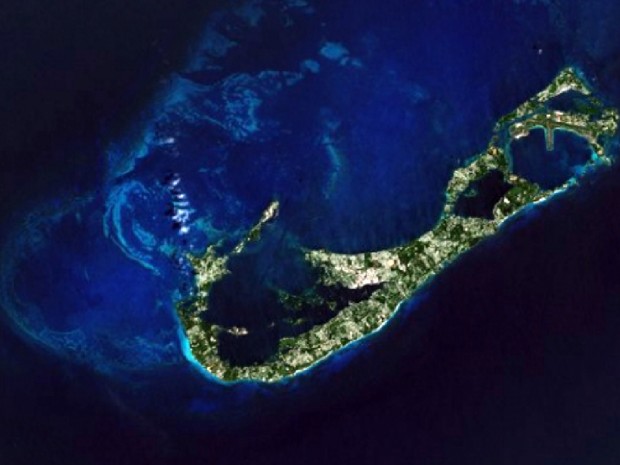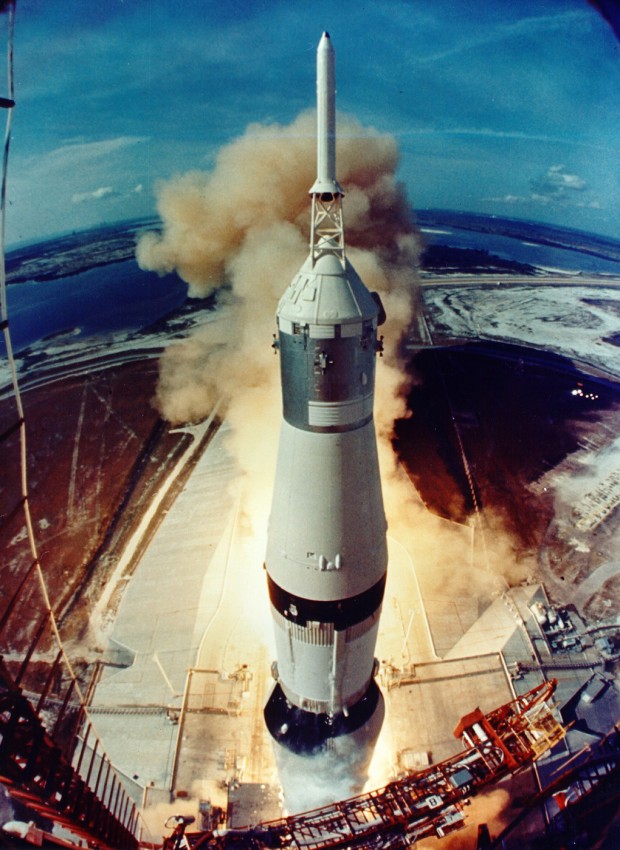Project Icarus: How MIT ‘Saved’ Bermuda
 At 12:26 p.m. on June 19, 1968 the asteroid Icarus, which is nearly a mile in diameter, will crash into the mid-Atlantic, just east of Bermuda.
At 12:26 p.m. on June 19, 1968 the asteroid Icarus, which is nearly a mile in diameter, will crash into the mid-Atlantic, just east of Bermuda.
Its impact — the equivalent of a 500,000-megaton bomb blast — will splash out some 1,000 cubic miles of sea water and form a crater 15 miles across in the ocean floor.
Bermuda will be largely obliterated by the immediate impact blast — some 22,000 times more powerful than the atomic bomb dropped on the Japanese city of Hiroshima in August, 1945. Any remaining fragments of the island will be deluged by tidal waves 100 feet high which will sweep across coastal cities on both sides of the ocean, and earthquakes 100 times worse than any ever recorded will be felt all over the world.
Clearly, Icarus must be stopped. No expense will be spared.
This was the apocalyptic scenario of Massachusetts Institute of Technology’s Project Icarus in the mid-1960s, with students charting the hypothetical course of a rogue asteroid on a near-collision course with Bermuda — and conjuring with ways to prevent the catastrophe.
Astronomer Walter Baade used the 48-inch reflecting telescope at Palomar Observatory in southern California to capture mankind’s first image of asteroid 1566 Icarus on June 26, 1949.
Icarus, it was soon found, is unusual because its elliptical orbit takes it from the inner edge of the Main Asteroid Belt between the orbits of Mars and Jupiter to well within Mercury’s orbit.
Icarus needs 1.12 years to circle the Sun once. Every 19 years, always during the month of June, Icarus and Earth pass near each other at a relative velocity of about 18 miles per second. Baade detected Icarus during one of these close encounters.
MIT Professor Paul Sandorff taught the Interdepartmental Student Project in Systems Engineering in the Spring 1967 Term at MIT in Boston. He noted that Icarus and Earth would pass each other at a distance of four million miles — about 16 times the Earth-moon distance– on June 19, 1968.
Discovery Channel simulation of large asteroid collision with Earth
He then asked his students to suppose that, instead of missing earth on that date, Icarus would strike in the Atlantic Ocean east of Bermuda with the explosive force of 500,000 megatons of TNT.
Professor Sandorff gave his class until May 27, 1967 to develop a plan for averting the catastrophe.
In 1967, the physical characteristics of Icarus were little known. For purposes of their study, Dr. Sandorff’s students assumed that it measures 4200 feet in diameter and has a density of 3.5 grams per centimeter, yielding a mass of 4.4 billion tons.
For comparison, earth has an average density of 5.5 grams per cubic centimeter.
They acknowledged, however, that, given its orbit, which resembles that of a short-period comet, Icarus might be a defunct comet nucleus. In that case, its density and mass would likely be considerably less. They also assumed that it is a solid body; that is, that it is not made up of small pieces held together loosely by weak mutual gravitational attraction.
In March 1967, the MIT students visited Cape Kennedy, Florida, to size up US space capabilities. At the time, the first manned flight of the Apollo Command and Service Module [CSM] had been postponed indefinitely following the Apollo 1 fire which killed Gus Grissom and two other atronauts on January 27, 1967 and the Saturn V moon rocket had yet to fly [Apollo 4, the successful first Saturn V test flight, would not occur until November 9, 1967].
Nevertheless, the students wrote that “the awesome reality” of the Vertical Assembly Building [VAB], in which the Saturn V and Apollo spacecraft would be prepared, and the twin Launch Complex 39 pads [Pads A and B], from which they would be launched, had “completely erased” any doubts that they might have had about using Apollo/Saturn technology in their project.
Professor Sandorff’s students proposed to hijack Project Apollo, delaying NASA’s first manned lunar landing by about three years. They would take over the first nine Saturn V rockets earmarked for the moon program, commence construction in April 1967 of a third Launch Complex 39 Saturn V launch pad [Pad C], and add a high bay to the VAB. Three Saturn Vs would be used for flight tests, and the remainder would each launch toward Icarus, each carrying heavily modified unmanned Apollo CSMs bearing enormous 44,000-pound nuclear warheads with a destructive yield of 100 megatons.
Though the MIT students did not mention it, a 100-megaton warhead was not a standard part of the US nuclear arsenal. Given the secrecy surrounding nuclear weapons during the Cold War, they might not have known that no warhead of such destructive yield had ever been built.
The most powerful nuclear bomb ever, the Soviet Union’s 60,000-pound “Tsar Bomba,” had exploded on October 30, 1961, with the force of 50 million tons of TNT. Only a single “Tsar Bomba” was built, and the US had not deigned to match the Soviet feat.
Detonation of the Soviet “Tsar Bomba” — so-called “King of the Bombs”
Hence, a 100-megaton nuclear device would have required development and testing. The MIT students did not include a nuclear weapon development and testing program in their Project Icarus plan.
The Icarus CSM — which the MIT students dubbed the Interceptor — would comprise three modules: a drum-shaped propulsion module corresponding to the Apollo Service Module [SM], with attitude-control thrusters and a Service Propulsion System [SPS] main engine; a drum-shaped payload module based on the SM’s structural design but containing the 100-megaton nuclear device; and a stripped-down Command Module [CM] containing Icarus detection sensors and an MIT-designed Apollo Guidance Computer modified for automatic operation. Unlike the two-module Apollo CSM, the three modules of the Interceptor would remain bolted together throughout its flight.
The first Project Icarus Saturn V [Saturn-Icarus 1] would lift off from Cape Kennedy on April 7, 1968, 73 days before the asteroid was due to collide with Earth. Its payload, Interceptor 1, would reach Icarus 60 days later, when the asteroid was 13 days and 20 million miles out from Earth. At about the time Interceptor 1 was due to reach its target, the MIT Lincoln Laboratory’s Haystack radar would detect Icarus for the first time.
Saturn-Icarus 2 would launch on April 22, 1968, 58 days before Icarus was due to strike. Interceptor 2 would reach its target 15.5 million miles and 10 days out from Earth. Saturn-Icarus 3 would lift off on May 6, 1968, 44 days before Icarus was due to arrive, and its Interceptor would reach Icarus one week and 11 million miles out from Earth. Saturn-Icarus 4 would lift off on May 17, 1968, 33 days before Icarus arrival, and Interceptor 4 would reach the asteroid 28 days later, when Earth and Icarus were 7.7 million miles apart.
Saturn-Icarus 5 would leave Earth near dawn on the U.S. east coast on June 14, 1968, and Interceptor 5 would reach Icarus 1.4 million miles out from Earth, 22 hours before expected impact. By then, the asteroid would appear as a modest star in the pre-dawn sky near the constellation Orion. Saturn-Icarus 6 would lift off a few hours after Saturn-Icarus 5. Icarus would be about 20 hours and 1.25 million miles from impact when Interceptor 6 reached it.
As each Interceptor closed to within a quarter-million miles of Icarus, an optical sensor in its nose would spot the asteroid. The SPS and thrusters would then adjust the Interceptor’s course to ensure a successful interception.
As the Interceptor closed to a distance of 550 feet of Icarus, a radar would detect the asteroid and trigger the nuclear device, which would explode at a distance of from 50 to 100 feet.
If the students’ assumptions about Icarus’s mass and density were correct, then each 100-megaton near-surface nuclear blast would excavate a bowl-shaped crater up to 1000 feet wide.
Bermuda as seen from space — the target of asteroid Icarus
The effect the explosions would have on Icarus’s course was, of course, not known with precision; the students calculated that each blast would alter its velocity by between eight and 290 meters per second.
The MIT students acknowledged that Icarus might shatter; in that event, subsequent Interceptors would target the largest fragments. Data from each Interceptor as it approached Icarus and from Earth-based optical telescopes and radars would be used to target subsequent Interceptors as needed. Conversely, if fewer than six explosions were sufficient to deflect or pulverize the asteroid, then the remaining Saturn V rockets and Interceptors would stand down.
All but one of the Interceptors would be joined at Icarus by a separately launched 540-pound Intercept Monitoring Satellite [IMS] based on the Mariner II design. Mariner II, the first successful interplanetary probe, had flown past Venus on December 14, 1962. In addition to data immediately useful for Project Icarus, the IMS would provide pure science data.
The first IMS would leave Earth atop an Atlas-Agena rocket on February 27, 1968. It would pass between 70 and 135 miles of Icarus at the time of the first explosion. This would place it outside of the zone of large high-velocity debris from the explosion, but within the zone of plasma, dust, and small debris. The IMS would analyze the small fragments and hot gases to gather data on Icarus’s composition. A 50-pound foam-honeycomb bumper would shield the IMS during passage through the debris cloud.
No IMS would monitor the fifth interception — if it occurred — unless the sixth interception were called off. The IMS for monitoring the sixth [or fifth]interception would lift off on June 6, 1968, between the Saturn-Icarus 4 and 5 launches.
Professor Sandorff’s class estimated that Project Icarus would cost $7.5 billion. It would, they calculated, stand a 1.5% chance of only fragmenting the asteroid. If this happened, then Icarus might cause even more damage to Earth than if it were permitted to impact intact. The probability that Project Icarus would reduce the damage Icarus would cause was, however, 86%, and the probability that it would succeed in preventing any part of the asteroid from reaching Earth was 71%.
During the June 1968 close approach, Icarus became the first asteroid detected using Earth-based radar.
Massive Saturn V rockets armed with 100 megaton warheads were to be fired at Icarus in the MIT scenario
During its next close approach, in June 1987, Icarus came no nearer Earth than about 15 million miles. During the June 1996 close approach Icarus and Earth were about 10 million miles apart.
Through data gathered during this close approaches, scientists found that Icarus is roughly spherical, rotates rapidly (about once every 2.25 hours), probably is a light-colored S-type asteroid made mostly of stony materials, and measures about 4600 feet across. Its density is probably about 2.5 grams per cubic centimeter. Its closest approach since June 1968 will occur on June 16, 2015, when Icarus will pass about five million miles from Earth.
Read More About
Category: All, History, technology





For anyone interested the full story is available through MIT Press..
http://mitpress.mit.edu/catalog/item/default.asp?ttype=2&tid=6840